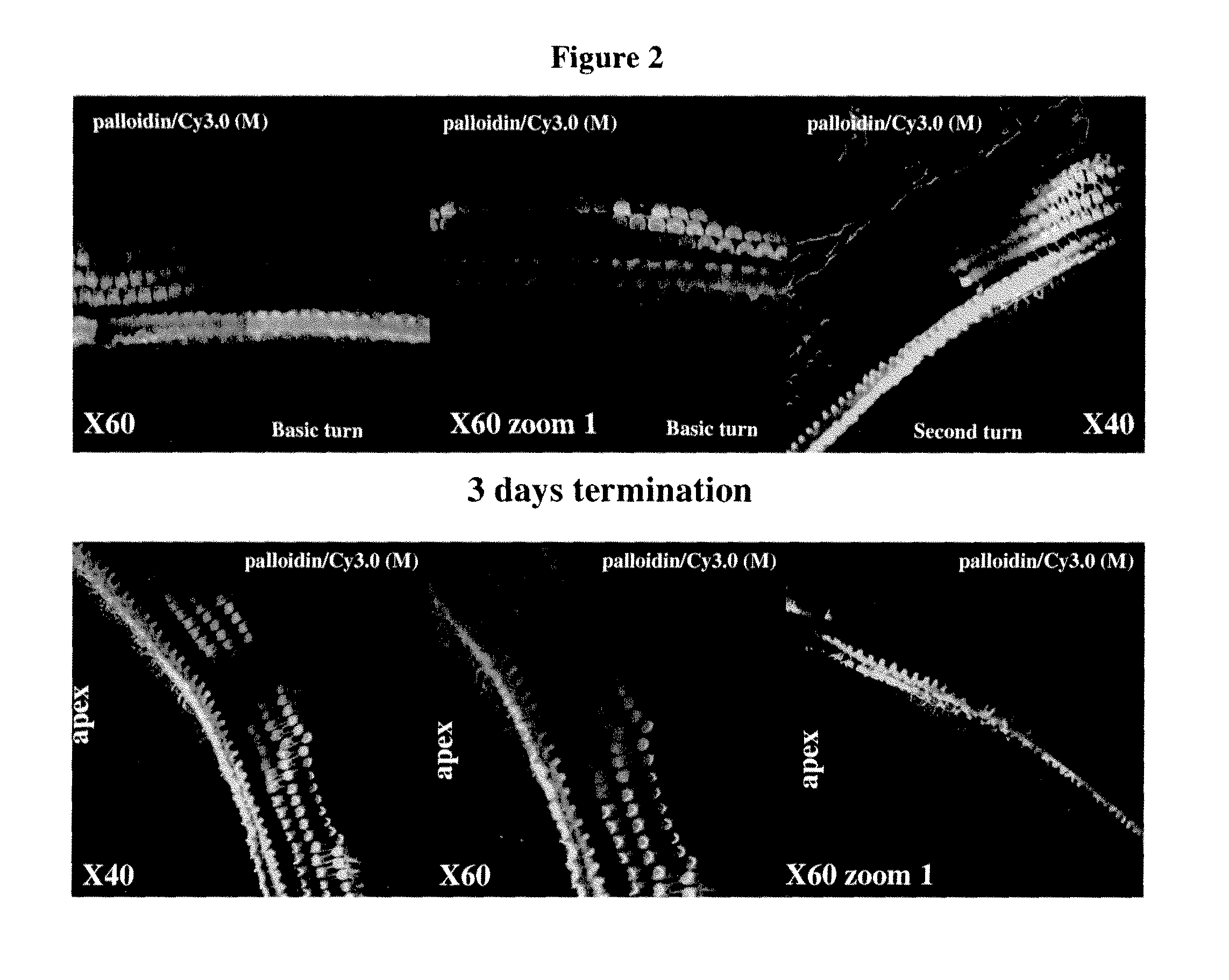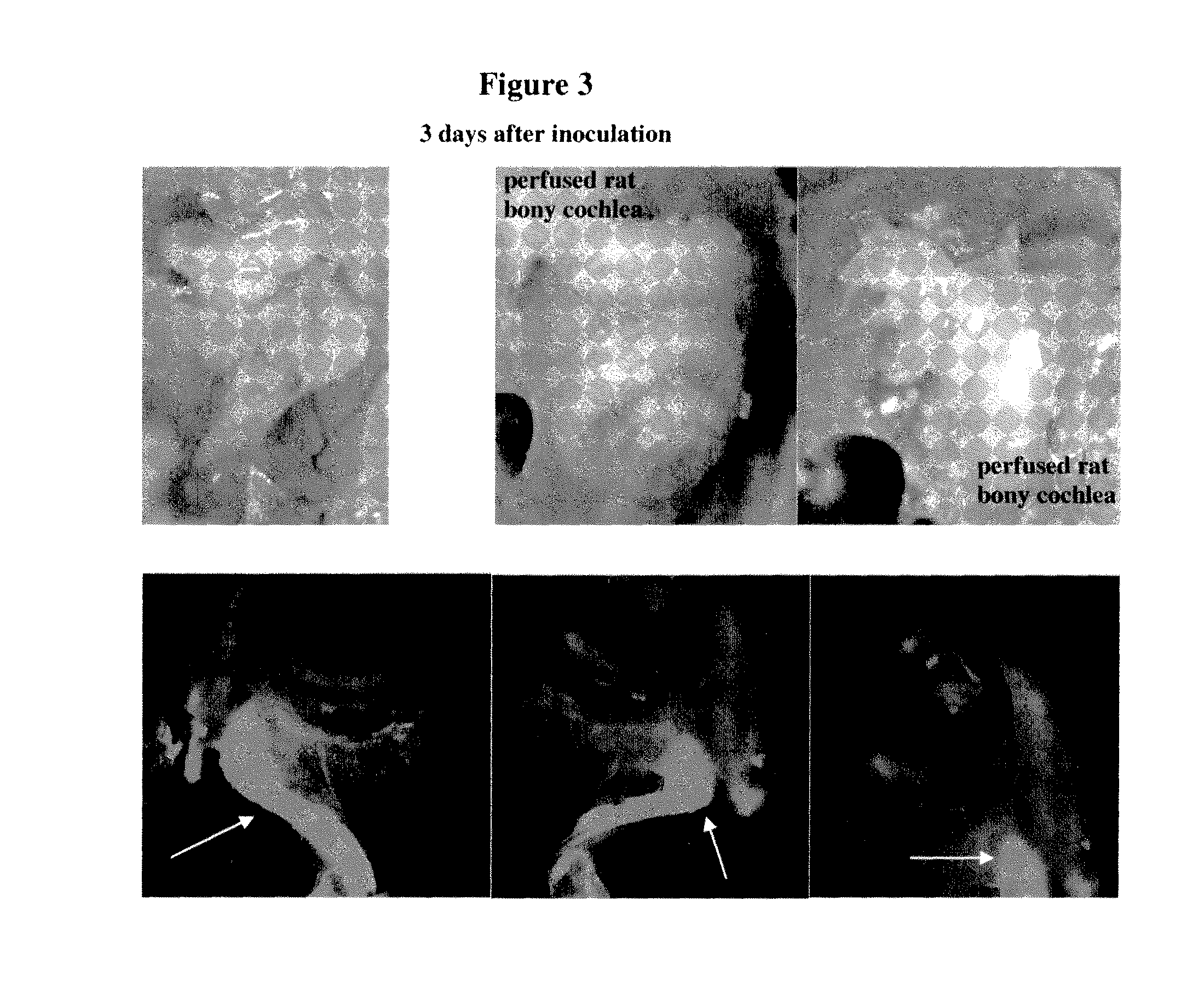Compositions and methods for treatment of ear disorders
a technology for ear disorders and compositions, applied in the field of compositions and methods for treating ear disorders, can solve the problems of ringing in the ears (tinnitus), hearing loss, and hair damage caused by loud noise, and achieve the effect of reducing or inhibiting the expression of genes
- Summary
- Abstract
- Description
- Claims
- Application Information
AI Technical Summary
Benefits of technology
Problems solved by technology
Method used
Image
Examples
example 1
In Vitro Testing of siRNA Compounds
[0434]About 1.5-2×105 tested cells (HeLa cells and / or 2931 cells for siRNA targeting human genes and NRK52 cells and / or NMUMG cells for siRNA targeting the rat / mouse gene) were seeded per well in a 6 well plate (70-80% confluent).
[0435]24 hours later, cells were transfected with siRNA compounds using the Lipofectamine™ 2000 reagent (Invitrogen) at final concentrations of 5 nM or 20 nM. The cells were incubated at 37° C. in a CO2 incubator for 72 hours.
[0436]As positive control for transfection PTEN-Cy3 labeled siRNA compounds were used. An additional positive control used was a blunt-ended 19-mer siRNA, i.e. x=y=19 wherein Z and Z′ are both absent. This siRNA was non-phosphorylated and had alternating ribonucleotides modified at the 2′ position of the sugar residue in both the antisense and the sense strands, wherein the moiety at the 2′ position is methoxy (2′OMe) and wherein the ribonucleotides at the 5′ and 3′ termini of the antisense strand are...
example 2
Middle / Inner Ear Delivery Routes of Cy3 Labelled DDIT4—1 siRNA
[0440]The objectives of the study were as follows: To establish procedures for topical, non-invasive delivery of a therapeutic oligonucleotide to the middle / inner ear.
[0441]To estimate the temporal pattern of distribution of siRNA DDIT4-Cy3 into cochlear structures, following instillation of pharmaceutical compositions into right external auditory canal in rats (REAC).
[0442]The substance tested was Cy3-labeled siRNA against RTP801 (DDIT4—1-Cy3) (sense strand: GUGCCAACCUGAUGCAGCU (SEQ ID NO:5843); antisense strand: AGCUGCAUCAGGUUGGCAC (SEQ ID NO:5844)).
[0443]Description of the test material: double-stranded Cy3-labeled 19-mer siRNA, Cy3 is linked to the 3′ end of the antisense strand via a dT nucleotide. Both sense and anti-sense strands harbor alternating 2′-OMe modifications on every odd nucleotide of the anti-sense strand and on every even nucleotide of the sense strand. Under sterile conditions, 42.43 mg of DD1T4—1-Cy3...
example 3
Examination of Inner Ear Non-Invasive Delivery of Formulated Cy3-DDIT4—1 siRNA in Rats
[0465]Description of the test material: double-stranded Cy3-labeled 19-mer DDIT4—1 siRNA, Cy3 is linked to the 3′ end of the antisense strand via an extra ‘dT’ nucleotide. Both sense and anti-sense strands harbor alternating 2′OMe sugar modified ribonucleotides on every odd nucleotide of the antisense strand and on every even nucleotide of the sense strand.
[0466]Three different formulations were tested:
[0467]Formulation 1: 100 μg of Cy3 DDIT4 siRNA in 10 μl of 30% glycerol.
[0468]Formulation 2: 100 μg of Cy3 DDIT4 siRNA in 10 μl of PBS.
[0469]Formulation 3: 100 μg of Cy3 DDIT4 siRNA in 10 μl of 20% mineral oil (v / v), 40% Propylene glycol (v / v) and 10% Ethanol (v / v).
[0470]Right external auditory canal (REAC) delivery: A 10 μl sample volume (warm formulated eardrops, 37° C.) was slowly instilled into external REAC, using blunt pipette tip. This volume was delivered into the right ear. During and after ...
PUM
| Property | Measurement | Unit |
|---|---|---|
| temperature | aaaaa | aaaaa |
| concentration | aaaaa | aaaaa |
| concentration | aaaaa | aaaaa |
Abstract
Description
Claims
Application Information
 Login to View More
Login to View More - R&D
- Intellectual Property
- Life Sciences
- Materials
- Tech Scout
- Unparalleled Data Quality
- Higher Quality Content
- 60% Fewer Hallucinations
Browse by: Latest US Patents, China's latest patents, Technical Efficacy Thesaurus, Application Domain, Technology Topic, Popular Technical Reports.
© 2025 PatSnap. All rights reserved.Legal|Privacy policy|Modern Slavery Act Transparency Statement|Sitemap|About US| Contact US: help@patsnap.com



